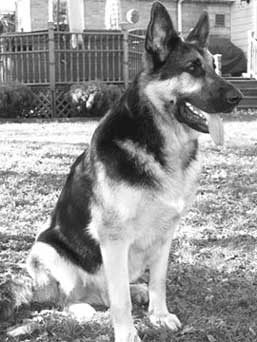Canine epilepsy in GSDs simply refers to repeated seizures.
Canine epilepsy in GSDs is a chronic condition characterized by recurrent seizures. Watching a beloved German Shepherd in the throes of a grand mal seizure is one of the most terrifying scenes a dog owner can witness.
The term "seizure" refers to the involuntary contraction of muscles which is caused by an electrical storm in the brain. Although seizures can always be considered as abnormal events, not all seizures in German Shepherds are caused by canine epilepsy.
There are so many different causes of chronic recurrent seizures in German Shepherds that canine epilepsy is not even considered a specific disease or even a single syndrome, but rather a broad and diverse category of disorders.
Canine epilepsy in GSDs can be caused by a variety of causes.
Other major causes of seizures in German Shepherds can be as the result
of: brain tumors; Liver Disease; low blood sugar; severe worm
infestation; Hypothyroidism; vaccinations; hydrocephalus; genetic
factors; infections, cysts and cancer; eclampsia; lead, chemicals and
poisoning.
Other causes of seizures and epilepsy in GSDs can be: head trauma; kidney failure; and vitamin deficiencies.

Epilepsy in GSDs is broadly divided into 2 distinct and different types - idiopathic and symptomatic.
Idiopathic epilepsy (also called primary epilepsy) is diagnosed when there is no known cause for the condition. It is often assumed that this may be an inherited condition.
The second type is called Symptomatic epilepsy (also called secondary epilepsy). This diagnosis is used when a specific cause for the seizures can be found. A veterinarian will usually run a series of tests to rule out possible causes before diagnosing the German Shepherd as having the idiopathic version.
Most German Shepherds with the idiopathic form of epilepsy suffer their first seizure between the ages of one and five years of age. A genetic basis for idiopathic epilepsy is strongly suspected in several breeds beside the German Shepherd - including the Beagle, Belgian Tervuren, Keeshond, Dachshund, Labrador Retriever, Golden Retriever and Collie. Idiopathic canine epilepsy is thought to have an inherited basis as well
Common Types of Seizures - Epilepsy in GSDs
There are two basic forms of epileptic seizures in German Shepherds - "Petit mal" or "partial motor seizures" (a less severe form of epilepsy) and "Grand mal". These major motor seizures are much more severe and can include a loss of consciousness and gross body movements.
A canine epileptic seizure in itself can be further broken down into four different stages.
1. The Prodome - This stage is typically characterized by changes in the dogs mood or behavior and can last from minutes to hours or longer before the manifestation of the actual seizure activity.
2. The Aura – When the owner first notices the initial signs including: pacing, licking, salivating, trembling, vomiting, wandering aimlessly, hiding, whining, etc.
3. The Ictus - This stage includes the actual seizure itself. It is a period of activity in which the dog may lose consciousness, gnash their teeth, thrash about with their head and legs, drool excessively, paddle their feet as if running as well as losing control of their bladders and bowels.
4. The Ictal – This stage occurs immediately after the seizure. The GSD may act drunk, doped, blind or deaf. Some will seem to pass out and just sleep. Other German Shepherds will show signs of pacing endlessly or drinking large amounts of water.
Common Symptoms your GSD May Suffer During a Seizure - Epilepsy in GSDs
A canine epileptic seizure may last anywhere from one to five minutes or longer. Afterward when it is over the GSD may seem exhausted, confused and disoriented. Some of the symptoms you can expect during an epileptic seizure are: sudden, violent shaking; stiffness; loss of consciousness; urinating; salivating; muscle twitching; staring, altered vision.
Since your veterinarian will probably not witness one of your GSD's seizures, they will be very dependent upon your description of the seizure episode. Many other problems such as fainting or dizzy spells can also come and go like seizures and may look similar to canine epilepsy to the untrained eye.
Because of this your veterinarian will need as clear a description of what you observed during the seizure episode as possible to help make the distinction between this or other diseases. To help your veterinarian later on it is a good idea to write down a description of exactly what you saw as soon as possible after the episode.
Epilepsy in GSDs - commonly used treatments
A canine epileptic seizure may last anywhere from one to five minutes or longer. Afterward when it is over the GSD may seem exhausted, confused and disoriented. Some of the symptoms you can expect during an epileptic seizure are: sudden, violent shaking; stiffness; loss of consciousness; urinating; salivating; muscle twitching; staring, altered vision.
Since your veterinarian will probably not witness one of your GSD's seizures, they will be very dependent upon your description of the seizure episode. Many other problems such as fainting or dizzy spells can also come and go like seizures and may look similar to canine epilepsy to the untrained eye.
Because of this your veterinarian will need as clear a description of what you observed during the seizure episode as possible to help make the distinction between this or other diseases. To help your veterinarian later on it is a good idea to write down a description of exactly what you saw as soon as possible after the episode.
Sign up for promotions, news, discounts, and the chance to win prizes for you and your German Shepherd


